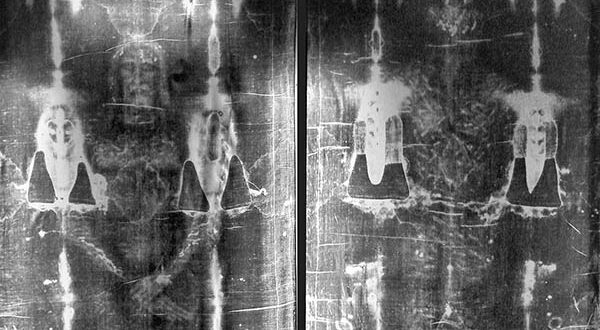The Shroud of Turin, also known as the Holy Shroud, is one of the most enigmatic and revered objects in the history of Christianity. This ancient cloth, measuring 4.4 meters in length and 1.1 meters in width, is believed by millions of Christians to be the burial cloth that wrapped the body of Jesus Christ after His crucifixion. On its surface, one can observe a faint yet unmistakable image of a man with marks that appear consistent with those from the Passion and Death of Jesus. This article explores the fascinating history of the Shroud of Turin, its theological implications, and its spiritual relevance to the daily lives of Christians.
History of the Shroud: Origins and Mystery
The origin of the Shroud of Turin has sparked interest and controversy for centuries. Although detailed historical records about its existence before the 14th century are scarce, tradition and some indirect evidence suggest that this shroud may have been present since the era of the early Christians. According to the Gospels, Joseph of Arimathea wrapped Jesus’ body in a linen cloth after taking it down from the cross and laid it in a tomb (Matthew 27:59; Mark 15:46). This detail fuels the possibility that the Shroud of Turin could be that very cloth mentioned in Scripture.
First Documented Appearance in History
The first documented reference to the Shroud dates back to Lirey, France, in 1353. However, it was not until the 15th century, when the Shroud was moved to Chambéry and later to Turin, that it began to attract widespread attention and debate. In 1898, Italian photographer Secondo Pia took the first photograph of the Shroud, and upon developing it, he discovered that the image in the negative revealed a strikingly clear face and detailed features. This discovery sparked an unprecedented scientific interest in the Shroud of Turin.
Science and Controversy: Carbon Dating and Scientific Studies
In 1988, a team of scientists conducted a carbon-14 dating test to determine the Shroud’s age. The results of this analysis dated it to between 1260 and 1390, sparking significant controversy, as this placed the Shroud in the Middle Ages, well after Jesus’ death. However, these findings have been challenged numerous times due to the possibility of contamination and the natural wear and tear of the cloth. Since then, numerous studies have questioned the accuracy of the carbon dating and highlighted the technical limitations and issues that may have affected the analysis.
Beyond the dating studies, researchers have conducted detailed scientific investigations on the image itself, using X-ray, infrared technology, and advanced microscopy. To this day, no researcher has been able to fully replicate how the image was imprinted on the fabric or explain how it was formed. Unlike any work of art or painting, the image on the Shroud does not penetrate the fabric’s fibers but rather appears to be on the surface, with no traces of pigment or paint.
Theological Significance of the Shroud of Turin
For believers, the Shroud of Turin is far more than an ancient relic or a scientific mystery; it is a tangible testament to the Passion, Death, and Resurrection of Christ. The image of the man on the shroud bears the signs of crucifixion: wounds on the wrists and feet, marks of scourging, and a crown of thorns. These marks remind Christians of the sacrifice Jesus made for humanity and His unconditional love.
The Shroud of Turin also holds profound theological relevance regarding the mystery of the Incarnation. Christianity teaches that God became man in the person of Jesus, experiencing pain, suffering, and death. The image on the shroud symbolizes this suffering humanity of Christ and His total self-giving out of love. Reflecting on the Shroud, the faithful are called to contemplate the meaning of the cross and resurrection in their own lives.
Moreover, the Shroud challenges believers to deepen their faith, inviting them to a personal relationship with Jesus and to see it as a reminder of the Christian message of hope: that death does not have the last word and that resurrection is the ultimate promise.
Spiritual and Practical Applications: How Can the Shroud Inspire Our Daily Lives?
For Christians, the Shroud of Turin can serve as a tool for meditation and reflection. Contemplating the image of the crucified Christ on the shroud reminds us of the centrality of the cross in Christian life. This cross speaks of love, sacrifice, and redemption, inviting us to consider how we can bring these values into our daily lives.
Reflection on Suffering and Empathy
The Shroud can be a source of comfort for those going through times of pain or difficulty. The image of the suffering Christ reminds us that God is not indifferent to human suffering; He knows it and experiences it firsthand. By meditating on the shroud, we can find solace in knowing that we are not alone in our struggles and that our pain can be redemptive if we offer it to God.
A Call to Humility and Service
The image of Jesus on the Shroud reminds us of His humility and selfless sacrifice. The same God who created the universe humbled Himself to the point of suffering death on the cross. This example calls us to live with humility, to serve others, and to seek ways to sacrifice our own interests for the good of others.
The Resurrection as a Hope of Eternal Life
While the Shroud of Turin represents the death of Jesus, it is also a symbol of His resurrection. Christian hope is based on Christ’s victory over death, and the shroud invites us to live with an eternal perspective. It reminds us that, although we may face challenges and suffering in this life, our true hope lies in the eternal life that Christ has promised us.
The Mystery Continues: The Shroud Today
Today, the Shroud of Turin remains a subject of devotion, study, and scientific investigation. For some, it represents a mystery that science has yet to fully explain. For others, it is a manifestation of faith that transcends human logic. Every year, thousands of pilgrims visit the Cathedral of St. John the Baptist in Turin to view it and meditate on the profound meaning it holds for their faith.
The Shroud is a reminder that not everything in life can be fully understood, and that mystery is part of the human experience. In a society that increasingly values immediate answers and scientific logic, the Shroud challenges us to accept that there are realities beyond our understanding. This mystery can nourish our faith and help us embrace our relationship with the transcendent with humility.
Conclusion: The Shroud of Turin, a Bridge Between Faith and Science
The Shroud of Turin is an icon that continues to inspire, challenge, and strengthen the faith of millions worldwide. Regardless of whether science ever fully resolves how the image was formed, its spiritual value and impact on Christian faith remain undiminished.
The story of the Shroud of Turin and its mysteries remind us that our faith is not in a piece of cloth, but in the Christ that cloth represents. As we reflect on it, we are reminded of Jesus’ sacrifice and His message of love, humility, and redemption. The Shroud of Turin calls us to live our faith authentically, embracing mystery, trusting in God, and striving to follow Jesus’ example in our daily lives.






